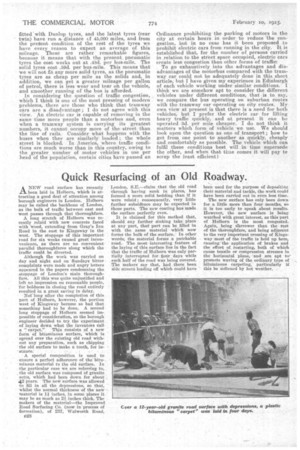Quick Resurfacing of an Old Roadway.
Page 12

If you've noticed an error in this article please click here to report it so we can fix it.
ANEW road surface has recently been laid in Holborn, which is attracting a good deal of attention among borough engineers in London. Holborn may be called the backbone of London, as the bulk of traffic between east and west passes through that thoroughfare.
A long stretch of Holborn was recently relaid with new concrete faced with 'wood, extending from Gray's Inn Road in the east to Kingsway in the west. The stoppage of this important 'road for six weeks caused great inconvenience, as there are no convenient parallel thoroughfares along which the traffic could be diverted.
Although the work was carried on day and night and on Sundays bitter complaints were made and angry letters appeared in the papers condemning the stoppage of London's Main thoroughfare. All this was quite unjustified and left no impression on reasonable people, for boldness in closing the road entirely resulted in a great saving in delay.
Not long after the completion of this part of Holborn, however, the portion west of Kingsway became so bad that something had to be done. A second long stoppage of Holborn seemed impossible of consideration, so the borough engineer decided to try, the experiment of laying down what the inventors call. a "carpet." This consists of a new form of bituminous surface, which is spread over the existing old road without any preparation, such as chipping the old surface to make a tooth, for in.. stance.
A special composition is used to ensure a perfect adherence of the bitu
•• minous material to the old surface. In the particular case we are referring to, , the old surface was composed of granite setts, which had been down for about 42 years. The new surface was allowed to fill in all the depressions, so that, whilst the normal thickness of the new material is 1+ inches, in some places it may be as much as 2+ inches thick. The makers of the material—the Improved Road Surfacing Co. (now in process of formation), of 237, Walworth Road,
028 London, S.E.—claim that the old road through having sunk in places, has formed a more solid bedding than if it were relaid ; consequently, very little further subsidence may be expected in those parts. The new coating has made the surface perfectly even.
It is claimed for this method that, should any further sinking take place at any part, that part can be filled in with the same material which now forms the bulk of the surface. In other words, the material forms a patchable road. The most interesting feature of the laying of this surface lies in the fact that the traffic of Holborn was only partially interrupted for four days while each half of the road was being covered. The makers say that, had there been side streets leading off which could have
been used for the purpose of depositing their material and tackle, the work could have been carried out in even less time.
The new surface has only been down for a little more than four months, so it is too early to speak about results. However, the new surface is being watched with great interest, as this part of Holborn is the most congested. Again, being iffirrower than the rest of the thoroughfare, and being adjacent to the very important crossing of Kingsway most of the traffic is held up here, causing the application of brakes and the effort of restarting, both of which cause tensile or compression stresses in the horizontal plane, and are apt to promote waving of the ordinary type of bituminous carpeting, particularly iE this be softened by hot weather.














































